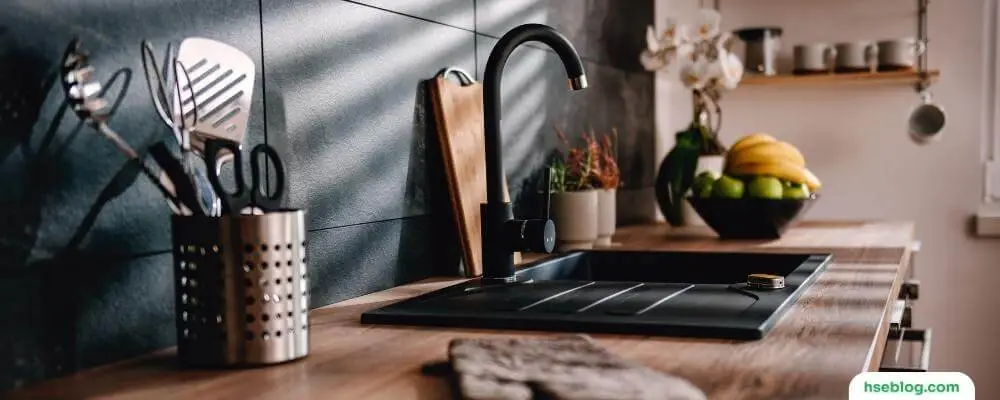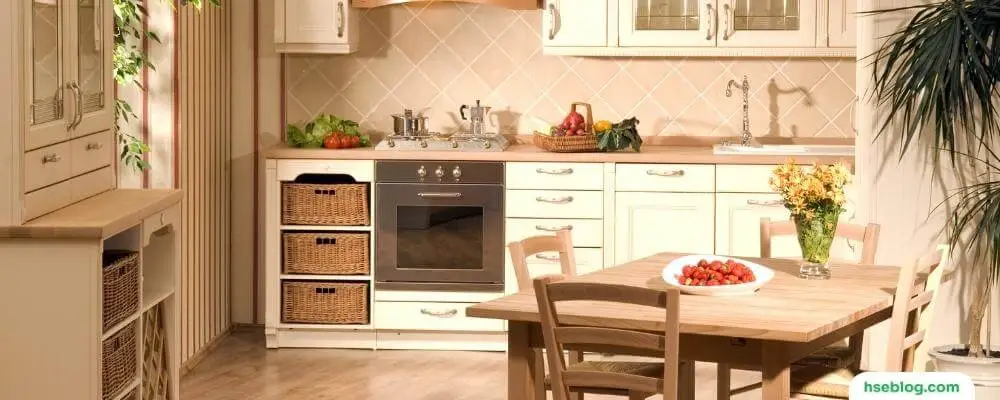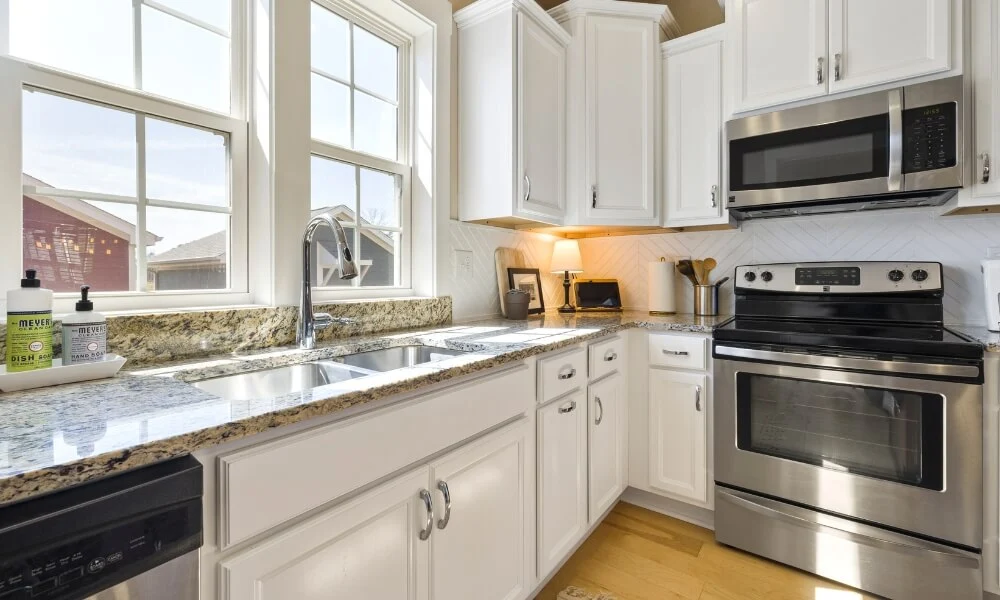Every room in our homes serves a unique purpose, and the kitchen is no exception. Often considered the heart of the home, the kitchen is where mouthwatering meals are prepared and memorable family moments are made. However, potential risks can often be overlooked. From sizzling pans to razor-sharp knives, the hazards are plentiful and varied. Our comprehensive guide highlights these often unconsidered dangers, making your safety our top priority.
In this blog post, we have curated a list of 18 vital kitchen safety tips, each elaborated upon to help you better understand their importance. This isn’t just a guide for the budding chef trying to avoid culinary calamities but also for the experienced home cooks looking to revisit and reinforce their knowledge of kitchen safety.
These tips form an essential framework for creating a safer kitchen environment, minimizing accidents, and fostering confidence as you navigate the heart of your home. So, let’s embark on this critical journey towards enhancing kitchen safety, blending caution and culinary skills seamlessly for a safe and joyful cooking experience. Let’s redefine cooking not only as an art or a daily chore but also as an activity where safety comes first. So, pull out your apron and prepare to deep-dive into a world where kitchen safety takes centre stage.

Kitchen Safety Importance
Kitchen safety is a topic of utmost importance that often doesn’t get the attention it deserves. A kitchen, whether at home or in a professional setting, is filled with potential hazards such as sharp utensils, hot surfaces, electrical appliances, and slippery floors. Ensuring kitchen safety is vital for several reasons:
- Preventing Injuries: The most immediate reason kitchen safety is important is to prevent physical harm. Knives can cut, hot surfaces burn, and wet or cluttered floors can cause slips and falls. Adhering to kitchen safety rules can significantly decrease the likelihood of these incidents occurring.
- Avoiding Fire Hazards: The kitchen is a common site of fires in homes due to flammable materials like oil and gas. Safe practices such as never leaving cooking unattended, keeping flammable objects away from the stove, and having a fire extinguisher can help prevent these dangerous situations.
- Preventing Foodborne Illness: Kitchen safety isn’t just about preventing cuts and burns; it’s also about ensuring food safety. Improper food handling can lead to foodborne illnesses. Proper storage, washing hands, and keeping utensils and surfaces clean can help keep your meals safe.
- Maintaining a Healthy Environment: A clean and safe kitchen promotes a healthier environment. Regular cleaning prevents the buildup of bacteria, mold, and pests.
- Increasing Cooking Efficiency: A well-organized and safe kitchen can improve your cooking experience and make it more efficient. When tools are stored safely and are easily accessible, meals are easier and quicker to prepare.
- Teaching Responsibility: Especially in households with children, teaching kitchen safety is a good way to instill a sense of responsibility. Learning to handle kitchen tools safely, clean up spills immediately, and respect potential dangers can be valuable life lessons.
By understanding the importance of kitchen safety, we can respect the potential dangers, implement strategies to mitigate risks and create a safer environment for ourselves and our families. It’s an integral part of cooking and an important life skill.

Kitchen Safety Rules
Kitchen safety is crucial to prevent accidents and ensure a secure cooking environment. Here are some essential kitchen safety rules to follow:
1. Never Leave Cooking Food Unattended
It is tempting to cook food on the stove while attending to other tasks. However, leaving cooking food unattended, even for a moment, can lead to disastrous consequences. Fires can start and rapidly spread in the kitchen if cooking oil overheats or flammable materials come into contact with the stove or oven. Moreover, unattended cooking can result in overcooked or burned food, leading to smoke and potential fire hazards. Hence, always turn off the stove or oven if you need to leave the kitchen for any reason.
2. Wiping Up Spills Right Away And Keeping The Counters And Floors Clean
Keeping your kitchen clean is more than just maintaining hygiene—it’s about safety, too. Spills can happen at any time in the kitchen, leading to slippery surfaces. Wet or greasy floors and countertops can cause people to slip and fall, potentially leading to serious injuries. Therefore, cleaning up spills promptly and maintaining clean kitchen surfaces can reduce the risk of accidents.
3. Keep Kitchen Knives Out Of Reach Of Children
Kitchen knives are essential tools for cooking, but they can be extremely dangerous, especially for children. Even with the best intentions, kids might be tempted to play with or misuse these sharp objects, risking cuts or more serious injuries. Therefore, knives should be stored safely in a knife block or drawer with a safety latch. Consider using magnetic strips installed high on the wall, where only adults can reach them.
4. Keep A Fire Extinguisher In The Kitchen In Case Of A Kitchen Fire
Despite our best efforts, kitchen fires can still occur. A fire can quickly escalate, causing extensive damage and risking lives. A fire extinguisher is a vital safety tool in any kitchen, allowing you to control or extinguish small fires before they become larger. Check the fire extinguisher periodically to ensure it’s in good working order, and learn how to use it properly.
5. Follow The Manufacturer’s Instructions When Using Kitchen Appliances
Kitchen appliances are designed to make our lives easier, but misuse can result in accidents or damage to the appliance. Reading and following the manufacturer’s instructions ensure the appliances are used correctly and safely. This includes understanding safety features, proper cleaning methods, and appropriate settings for different types of food.

6. Never Use The Stove Or Oven To Heat Your Kitchen
Although it might seem like a quick solution during cold weather, using your stove or oven as a heat source can be risky. This misuse can lead to carbon monoxide poisoning or a house fire. Instead, use proper heating devices, such as space heaters or central heating, and make sure you follow proper gas stove safety guidelines to avoid any potential hazards.
7. Be Aware Of What You Are Wearing While Cooking. Loose Clothing Can Catch Fire Easily
Loose or flammable clothing can pose a safety hazard in the kitchen. Loose sleeves or flaps can easily contact hot surfaces or open flames, causing clothes to catch fire. Always wear well-fitted clothing while cooking, and avoid synthetic materials that melt easily.
8. Keep Your Hair Pulled Back While Cooking
Like loose clothing, loose hair can pose a safety risk in the kitchen. Hair can catch fire if it comes into contact with open flames or becomes a sanitary issue if it falls into the food. Therefore, if you have long hair, tie it back securely while cooking.
9. Do Not Cook If You Are Tired Or Have Been Drinking Alcohol
Impaired judgment or slower reaction times due to fatigue or alcohol consumption can lead to accidents in the kitchen. You may be more likely to forget a pot on the stove, mishandle a knife, or ignore safety precautions. Eating something that doesn’t require cooking or waiting until you’re more alert is better.
10. Keep The First-aid Kit In The Kitchen In Case Of Accidents
Even with all the precautions in place, accidents can still happen. A first-aid kit in the kitchen allows you to respond quickly to minor injuries. The kit should include bandages, antiseptic wipes, burn cream, tweezers, and a digital thermometer. Having a list of emergency numbers in or near the kit is also a good idea.
Remember, it’s better to prevent accidents than deal with the aftermath. By following these kitchen safety rules, you can enjoy cooking while ensuring your and your family’s safety.

Additional Kitchen Safety Rules
In addition to the previously mentioned kitchen safety rules, here are a few more tips that can help enhance safety in your kitchen:
- Store Heavy Items Properly: Store heavy pots, pans, and other items at waist level. Storing these items too high can lead to accidents when trying to reach them.
- Use Safety Devices: Use safety devices such as oven mitts when handling hot items and splatter screens when cooking food that might splatter, such as frying oil.
- Turn Pot Handles Inward: When cooking on the stove, always turn the pot handles inward to prevent them from being knocked over.
- Avoid Overloading Electrical Outlets: Don’t overload electrical outlets with too many appliances. This could lead to electrical fires.
- Secure Loose Rugs: Use non-slip mats under rugs to prevent slipping.
- Proper Ventilation: Make sure your kitchen is well-ventilated to prevent the accumulation of harmful smoke or gases.
- Regular Maintenance: Inspect and maintain appliances to ensure they function correctly and safely.
- Child and Pet Safety: If you have children or pets, consider installing safety gates to keep them out of the kitchen while cooking.
- Mindful of Sharp Objects: Carefully dispose of broken glass or sharp can lids. Consider investing in a can opener that leaves smooth edges to reduce the risk of injury.
- Avoid Cross Contamination: Use separate cutting boards for raw and cooked foods to prevent cross-contamination.
Conclusion
In conclusion, our guide has been tailored to enlighten you on the critical yet often overlooked aspects of kitchen safety. Implementing these essential tips is a surefire way to turn your kitchen into a safe haven where culinary creativity thrives. Remember, safety isn’t just about preventing accidents; it’s about fostering a serene and secure environment that enhances your cooking experience. So let’s make every culinary journey safe, applying these 18 vital safety tips as our roadmap to a safer, more confident, and enjoyable cooking adventure.

